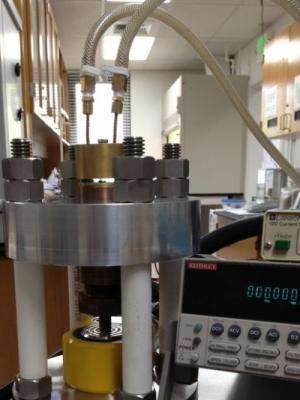New invention captures Earth's chemical reactions

(Phys.org) —Researchers have found a new way to study chemical reactions that occur deep in the Earth's crust.
The method, developed by an international team of researchers, means that it is now possible for geochemists to find out what kind of chemistry is happening deep in the Earth's crust, beyond the reach of boreholes.
The instrument, which can be used to study chemical reactions under very high pressures, is published online in the journal Angewandte Chemie.
Using nuclear magnetic resonance measurements (NMR), the instrument allows researchers to study chemical reactions at higher pressures and with much higher sensitivity than before.
The device, which is a type of NMR probe head, contains a radio-frequency coil wrapped around a small compressible sample cell which is suspended in a pressurised liquid, contained in a piston-cylinder pressure cell. By exciting the sample with radio waves and looking at how it relaxes, information about the chemistry happening inside can be obtained.
One of the researchers involved in the study, Dr C. André Ohlin from the Faculty of Science at Monash University, said this will allow greater insights into chemical reactions as they occur under extreme pressures deep underground.
"Geochemists know that chemical reactions deep in the Earth's crust can affect water and minerals that eventually migrate to the surface. But we've been unable to measure this accurately until now," he said.
"Our new device changes this. We can now get a much more detailed picture of what is happening deep in the Earth's crust by using this high pressure instrument" Dr Ohlin said.
The device can carry out high-pressure NMR measurements on liquid samples at pressures up to 20,000 Earth atmospheres.
Researchers believe the instrument could also shed light on chemical processes involved in hydraulic fracturing, or "fracking," and the behaviour of buried nuclear waste over long periods of time.
Dr Ohlin said the method replicates high-pressure conditions at the base of the crust up to 70 km below the surface, allowing researchers to gain greater insights into Earth's chemistry.
"There are other methods of achieving high pressures like this such as using diamond-anvil cells, but they only allow very small samples. That makes it very difficult to study the really geochemically interesting systems, which contain atoms such as boron, aluminum and silicon that require more sensitive methods," he said.
"Because our instrument allows for high-pressure, high-resolution and high-sensitivity heteronuclear NMR measurements, researchers will be able to look at more interesting things like the behaviour of aluminum and silicon, something that's never been done before at these pressures. Eventually this will help us better understand how minerals form—and where to look for them."
The research was selected for the front cover of Angewandte Chemie.
More information: Pautler, B. G., Colla, C. A., Johnson, R. L., Klavins, P., Harley, S. J., Ohlin, C. A., Sverjensky, D. A., Walton, J. H. and Casey, W. H. (2014), "A High-Pressure NMR Probe for Aqueous Geochemistry." Angew. Chem. Int. Ed.. DOI: 10.1002/anie.201406751
Journal information: Angewandte Chemie , Angewandte Chemie International Edition
Provided by Monash University



















